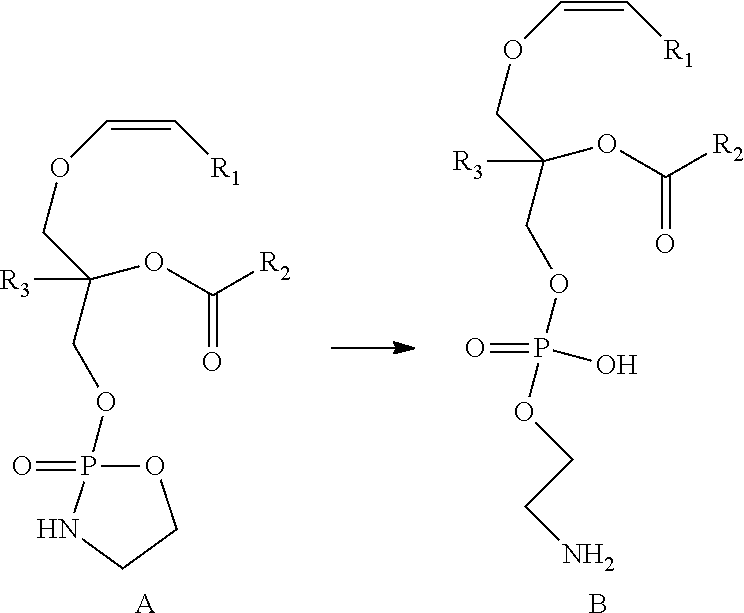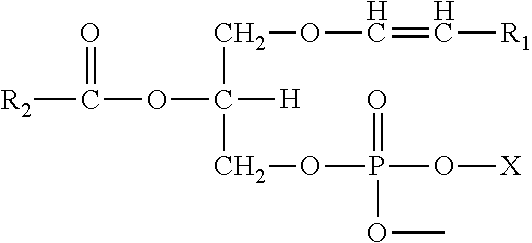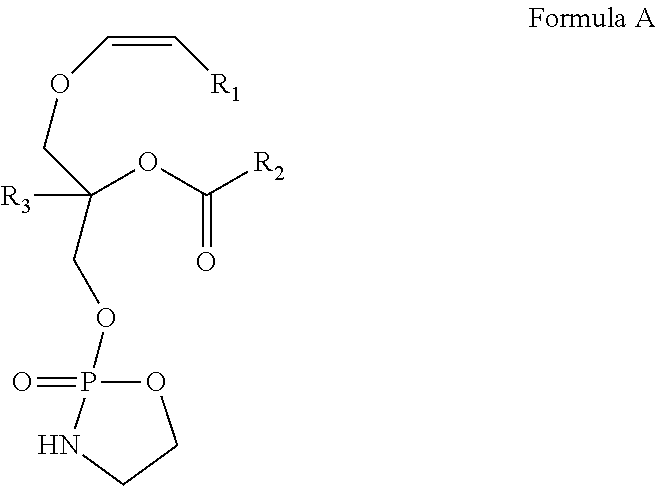Methods for the synthesis of plasmalogens and plasmalogen derivatives, and therapeutic uses thereof
a plasmalogen and plasmalogen derivative technology, applied in the field of plasmalogen and plasmalogen derivative synthesis, can solve the problems of large purification and expensive procedures, high cost of procedures, and the difficulty of achieving the effect of improving efficiency
- Summary
- Abstract
- Description
- Claims
- Application Information
AI Technical Summary
Benefits of technology
Problems solved by technology
Method used
Image
Examples
example 1
Synthesis of Iodotridecane
[0094]In a preferred embodiment of the invention, iodotridecane is the haloalkane used in the process of synthesizing the plasmalogen precursor. The iodotridecane can be obtained by chemical synthesis. The process for the same is explained in the details below.
Preparation of a Compound Represented by Formula (ii):
[0095]In the first step of the synthetic process the primary alcohol present in propargyl alcohol as represented by Formula (i) was protected by ether bond formation, by reacting it with DHA / PTSA and resulting in a compound represented by Formula (ii). The reaction scheme involved in this process is as follows:
[0096]
[0097]In a non-limiting embodiment, the raw materials used for this process are illustrated in Table 1:
[0098]
TABLE 1S.Name of theNo.MaterialQty.M. Wt.mmolMole Ratio1.Propargyl alcohol1g56.0616.9312.Dichloromethane15mL84.93—15vol.3.PTSA3mg—0.160.0094.DHP3mL84.1233.8625.NaHCO3—84.01——6.Dichloromethane2 × 100mL84.93—2 × 100vol.7.Water2 × 1...
example 2
Synthesis of a Cyclic Plasmalogen Precursor of Formula a by the 9-Step Chemical Synthetic Process
[0120]In a preferred embodiment of the invention, a 9-step synthetic process is provided for production of the novel cyclic plasmalogen precursor represented by Formula A wherein R1 is derived from iodotridecane, R2 is derived from docosahexanoic acid and R3 is hydrogen (See Scheme C). Each of the 9-steps in the chemical synthetic process will now be described in detail by way of the following example.
Preparation of a Compound of Formula 2 (4-(allyloxymethyl)-2,2-dimethyl-1,3-dioxolane)
[0121]In the first step of the synthetic process, solketal of Formula 1 was coupled to allyl bromide in the presence of NaH to produce a compound of Formula 2. The yield of the compound obtained in this reaction step was 88%. The reaction scheme involved in this process is as follows:
[0122]
[0123]In an exemplary embodiment, the raw materials used for this step are illustrated in Table 1a:
[0124]
TABLE 1aS.Nam...
example 3
Conversion of a Compound of Formula A to a Compound of Formula B
[0167]In a preferred embodiment of the invention, a one step synthetic process is provided for conversion of a compound represented by Formula A as obtained above to a compound represented by Formula B. An example of this method is described in detail below.
Preparation of a Compound of Formula B
[0168]A compound of Formula A as obtained above, comprising a cyclic phosphoethanolamine, was converted to a compound represented by Formula B in the presence of THF and H2O. The reaction scheme involved in this process is as follows:
[0169]
[0170]In an exemplary embodiment of this step, the compound represented by Formula A was dissolved in THF and stirred with water overnight, and we expect the disappearance of one of the two peaks in our analysis. As expected, HPLC and LCMS analysis indicated a single peak at retention time 17.44, with the mass 748 corresponding to the compound represented by Formula B. However, LCMS analysis of...
PUM
| Property | Measurement | Unit |
|---|---|---|
| temperature | aaaaa | aaaaa |
| temperature | aaaaa | aaaaa |
| temperature | aaaaa | aaaaa |
Abstract
Description
Claims
Application Information
 Login to View More
Login to View More - R&D
- Intellectual Property
- Life Sciences
- Materials
- Tech Scout
- Unparalleled Data Quality
- Higher Quality Content
- 60% Fewer Hallucinations
Browse by: Latest US Patents, China's latest patents, Technical Efficacy Thesaurus, Application Domain, Technology Topic, Popular Technical Reports.
© 2025 PatSnap. All rights reserved.Legal|Privacy policy|Modern Slavery Act Transparency Statement|Sitemap|About US| Contact US: help@patsnap.com



